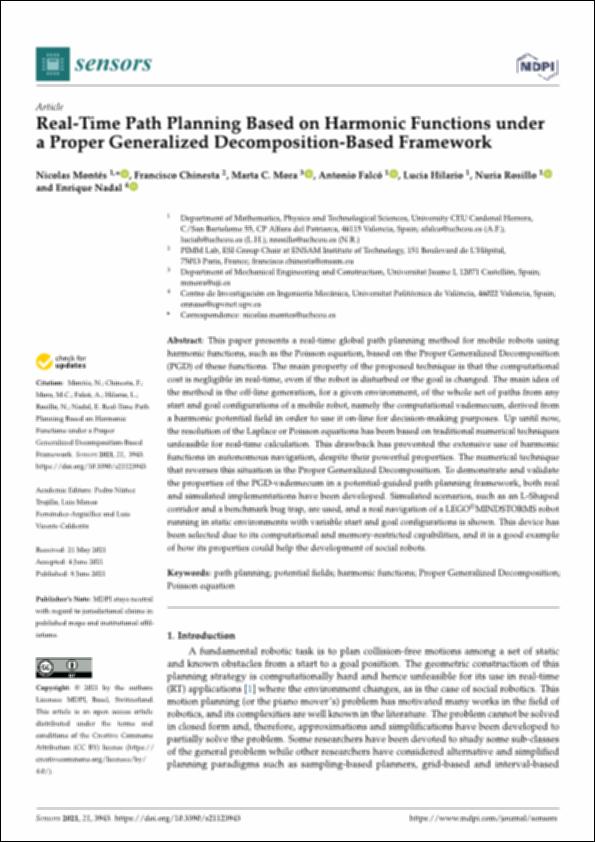Por favor, use este identificador para citar o enlazar este ítem:
http://hdl.handle.net/10637/13589Real-time path planning based on harmonic functions under a Proper Generalized Decomposition-Based framework
| Título : | Real-time path planning based on harmonic functions under a Proper Generalized Decomposition-Based framework |
| Autor : | Montés Sánchez, Nicolás Chinesta, Francisco Mora Aguilar, Marta Covadonga Falcó Montesinos, Antonio Hilario Pérez, Lucía Rosillo Guerrero, Nuria Nadal Soriano, Enrique |
| Materias: | Robótica.; Funciones armónicas.; Harmonic functions.; Descomposición (Matemáticas); Differential equations, Partial.; Robotics.; Autómatas matemáticos, Teoria de.; Machine theory.; Ecuaciones en derivadas parciales.; Decomposition (Mathematics) |
| Editorial : | MDPI |
| Citación : | Montés, N., Chinesta, F., Mora, M. C., Falcó, A., Hilario, L., Rosillo, N. & Nadal, E. (2021). Real-time path planning based on harmonic functions under a Proper Generalized Decomposition-Based framework. Sensors, vol. 21, i. 12 (08 jun.), art. 3943. DOI: http://dx.doi.org/10.3390/s21123943 |
| Resumen : | This paper presents a real-time global path planning method for mobile robots using harmonic functions, such as the Poisson equation, based on the Proper Generalized Decomposition (PGD) of these functions. The main property of the proposed technique is that the computational cost is negligible in real-time, even if the robot is disturbed or the goal is changed. The main idea of the method is the off-line generation, for a given environment, of the whole set of paths from any start and goal configurations of a mobile robot, namely the computational vademecum, derived from a harmonic potential field in order to use it on-line for decision-making purposes. Up until now, the resolution of the Laplace or Poisson equations has been based on traditional numerical techniques unfeasible for real-time calculation. This drawback has prevented the extensive use of harmonic functions in autonomous navigation, despite their powerful properties. The numerical technique that reverses this situation is the Proper Generalized Decomposition. To demonstrate and validate the properties of the PGD-vademecum in a potential-guided path planning framework, both real and simulated implementations have been developed. Simulated scenarios, such as an L-Shaped corridor and a benchmark bug trap, are used, and a real navigation of a LEGO®MINDSTORMS robot running in static environments with variable start and goal configurations is shown. This device has been selected due to its computational and memory-restricted capabilities, and it is a good example of how its properties could help the development of social robots. |
| Descripción : | Este artículo se encuentra disponible en la siguiente URL: https://www.mdpi.com/1424-8220/21/12/3943 Este artículo de investigación pertenece al número especial "Autonomous Navigation in Robotics: A New Challenge towards Social Robots". |
| URI : | http://hdl.handle.net/10637/13589 |
| Derechos: | http://creativecommons.org/licenses/by/4.0/deed.es |
| ISSN : | 1424-8220 (Electrónico) |
| Fecha de publicación : | 8-jun-2021 |
| Centro : | Universidad Cardenal Herrera-CEU |
| Aparece en las colecciones: | Dpto. Matemáticas, Física y Ciencias Tecnológicas |
Los ítems de DSpace están protegidos por copyright, con todos los derechos reservados, a menos que se indique lo contrario.


